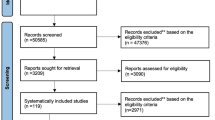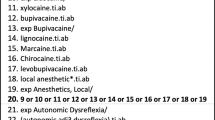Abstract
Data sources
The Cochrane Pain, Palliative and Supportive Care Group Trials Register, Cochrane Central Register of Controlled Trials, Medline, Embase, LILACS (Latin American and Caribbean Health Sciences), SIGLE (System for Information on Grey Literature in Europe)(for conference proceedings) and Science Citation Index were searched, along with the reference lists of all eligible trials, key textbooks and previous systematic reviews. Authors of all identified trials were contacted.
Study selection
Studies of interest were randomised controlled trials (RCT) or quasi-RCT comparing all topical applications of lidocaine, including gels and patches in people of all ages suffering from postherpetic neuralgia (PHN; pain persisting at the site of shingles at least 1 month after the onset of the acute rash).
Data extraction and synthesis
Data were extracted independently by two authors with disputes resolved by a third reviewer. A meta-analysis was conducted using a fixed-effect approach.
Results
Three trials were included, giving a total of 182 individuals who used topical lidocaine and 132 controls. Two trials provided data on pain relief, and the remaining study provided data on secondary outcome measures. The largest trial published as an abstract compared a topical lidocaine patch to a placebo patch and accounted for 150 of the 314 patients (48%). A meta-analysis combining two of the three studies identified a significant difference between the topical lidocaine and control groups for the primary outcome measure: a mean improvement in pain relief according to a pain relief scale. Topical lidocaine relieved pain better than placebo (P 0.003). There was a statistical difference between the groups for the secondary outcome measure of mean score-reduction on a visual analogue scale (P 0.030), but this was only for a single small trial. There were a similar number of adverse skin reactions in both treatment and placebo groups.
Conclusions
There is insufficient evidence to recommend topical lidocaine as a first-line agent in the treatment of PHN with allodynia. Further research should be undertaken on the efficacy of topical lidocaine for other chronic neuropathic pain disorders, and also to compare different classes of drugs (eg, topical anaesthetics versus anti-epileptics).
Similar content being viewed by others
Log in or create a free account to read this content
Gain free access to this article, as well as selected content from this journal and more on nature.com
or
References
Khaliq W, Alam S, Puri N . Topical lidocaine for the treatment of postherpetic neuralgia. Cochrane Database Syst Rev 2007; issue 2.
Thyregod HG, Rowbotham MC, Peters M, Possehn J, Berro M, Peterson KL . Natural history of pain following herpes zoster. Pain 2007; 128:148–156.
Rowbotham MC, Davies PS, Verkempinck C, Galer BS . Lidocaine patch: double-blind controlled study of a new treatments method for post herpetic neuralgia. Pain 1996; 65:39–44.
Rowbotham MC, Davies PS, Fields HL . Topical lidocaine gel relieves postherpetic neuralgia. Ann Neurol 1995; 37:246–253.
Dubinsky RM, Kabbani H, El-Chami Z, Boutwell C, Ali H . Quality Standards Subcommittee of the American Academy of Neurology practice parameter: treatment of postherpetic neuralgia: an evidence-based report of the Quality Standards Subcommittee of the American Academy of Neurology. Neurology 2004; 63:959–965.
Wareham D . Post-herpetic neuralgia. In Clinical Evidence Handbook. Charles Young. London: BMJ Publishing Group; 2007:pp264–265.
Author information
Authors and Affiliations
Additional information
Address for correspondence: Review Group Co-ordinator, Pain, Palliative and Supportive Care Group, Pain Research Unit, Churchill Hospital, Oxford, UK OX3 7LJ.
Khaliq W, Alam S, Puri N. Topical lidocaine for the treatment of post herpetic neuralgia. Cochrane Database Syst Rev 2007; issue 2
Rights and permissions
About this article
Cite this article
Zakrzewska, J. Insufficient evidence to recommend topical lidocaine as first-line treatment for postherpetic neuralgia. Evid Based Dent 8, 85–86 (2007). https://doi.org/10.1038/sj.ebd.6400514
Published:
Issue date:
DOI: https://doi.org/10.1038/sj.ebd.6400514



